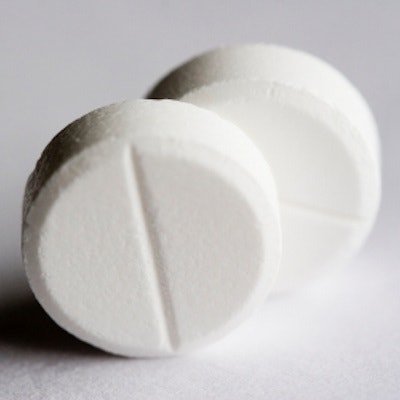
Some patients and dental practitioners favor the use of nonnarcotic analgesics or opioid alternatives for treating postoperative endodontic pain, but studies on their effectiveness for this indication have been conflicting. However, a new review suggests that nonsteroidal anti-inflammatory drugs (NSAIDs) and acetaminophen are potent options.
Researchers analyzed high-quality, placebo-controlled studies on the use of NSAIDs or acetaminophen for treating pain during the 24 hours after root canal treatment. They found that these drugs are effective at reducing postoperative endodontic pain compared with placebo. They also noted that other factors, such as dosing regimens and intraoperative pain, can affect a patient's pain levels.
"The main conclusion that can be drawn from this review is that there is a significant advantage to use analgesics over placebo for managing postoperative endodontic pain," wrote the study authors, led by Armin Shirvani, MD, from the Iranian Center for Endodontic Research at Shahid Beheshti University of Medicine Sciences in Tehran, Iran (Journal of Oral Rehabilitation, May 23, 2017).
Pain, pain go away
Postoperative pain is common after root canal treatment and thought to be related to the exacerbation of the inflammatory response and release of inflammatory mediators, such as prostaglandins. Nonnarcotic analgesics, including NSAIDs and acetaminophen, are an important pharmacological class for treating endodontic pain and reducing inflammation, according to the study authors.
“There is a significant advantage to use analgesics over placebo for managing postoperative endodontic pain.”
NSAIDs are believed to be effective, because they reduce the production of prostaglandins at sites of inflammatory. A weak inhibitor of peripheral prostaglandin synthesis, acetaminophen (also known as paracetamol) is an option for easing pain after endodontic treatment in patients with known sensitivities to NSAIDs or who have gastrointestinal ulcerations, the authors noted.
Some studies have suggested that nonnarcotic analgesics can lower the incidence of postoperative endodontic pain, while others have found that they have no such beneficial effect, they wrote. The researchers conducted the current review and meta-analysis to summarize current evidence on this topic and explore the relationship among various factors.
They searched multiple medical research databases for relevant studies, including only randomized, placebo-controlled studies that included the following criteria:
- Patients 15 years and older with a clinical diagnosis of irreversible pulpitis or pulpal necrosis undergoing single-session, nonsurgical primary root canal therapy
- Administration of multiple or single doses of nonnarcotic analgesics (NSAID or acetaminophen) pre-, intra-, or postoperatively by any route
- Outcome measure of postoperative pain intensity or pain relief with the first 24 hours after endodontic treatment
- Adequate statistical data for estimation of effect sizes
Ultimately, they included 27 placebo-controlled studies with 2,188 patients in their meta-analysis. In all studies, patients were randomized to receive a nonnarcotic analgesic or placebo, with pain intensity immediately after the procedure until 24 hours later as the main outcome measure.
Analgesics were given preoperatively in eight studies, intraoperatively in two studies, and postoperatively in nine studies. A single dose was provided in 24 studies and multiple doses in three. Monotherapy was administered in 22 studies and combination therapy in the remainder. Oral delivery was performed in the vast majority of studies, intracanal in one, and intraligamentary in two.
Eight studies provided data on pain scores immediately after root canal, 20 studies at six hours after the procedure, 15 studies at 12 hours, and 15 studies at 24 hours. Pooled results from each of these groupings found that analgesic use was significantly more effective than placebo at reducing pain at all of these times.
One strong predictor of improved analgesia and a lower pain score after root canal therapy in the current study was the type of NSAID used. At 24 hours, use of indomethacin or rofecoxib (previously sold as Vioxx before being removed from the market because of safety concerns) predicted lower pain levels. It remains unclear why there would be differences in efficacy between NSAIDs, and due to the limited number of comparative trials, there is little scientific reason to prefer one over the other, the authors wrote.
However, they noted that there is good evidence that preoperative NSAID administration is more effective than postoperative for relief of postoperative pain, although some studies have reported no difference between the two methods. Postoperative administration, though, appears better for pain relief at 24 hours after the procedure, they wrote.
"Consideration can therefore be given to either preoperative administration, or start the dosing immediately after the treatment session, before the offset of local anesthesia," the authors wrote.
They also found lower pain levels six hours after root canal with intraligamentary NSAID delivery. However, these findings were based on a small sample size and should be interpreted with caution, the authors added. They noted that drug response can vary among patients and recommend injecting NSAIDs in patients intolerant to oral analgesia, such as those with gastritis or asthma.
Supplementary injection also was more effective at achieving lower pain levels at 24 hours after endodontic treatment, especially in patients with inflamed pulp.
Based on their analysis, the authors made the following conclusions about the best ways to manage pain after root canal treatment using nonnarcotic analgesics:
- Administration of multiple-dose regimens during the postoperative period can achieve "the most efficacy."
- The need for supplementary anesthesia may predict pain duration.
- Alternatives, such as combination therapy and ligamentary injection, can reduce the duration of inflammation.
- Various types of analgesics have different efficacy, which can be influenced by other treatment strategies.
Heterogeneity limits conclusions
The authors acknowledged some weaknesses of their review. The analgesic regimens used in the studies varied, although the statistical technique of meta-regression that the authors used partially compensated for this. Additionally, reporting of covariates was not consistent among the studies.
While they advised cautious interpretation of their results, the authors noted that clinicians can manage patients' postoperative pain after root canal therapy with nonnarcotic analgesics, such as NSAIDs and acetaminophen.
"We provide evidence on the potency of nonnarcotic analgesics in treatment of postoperative endodontic pain," they concluded.



















